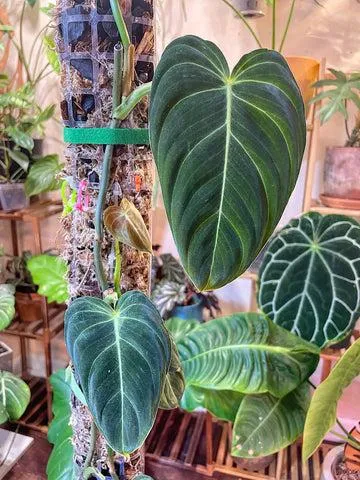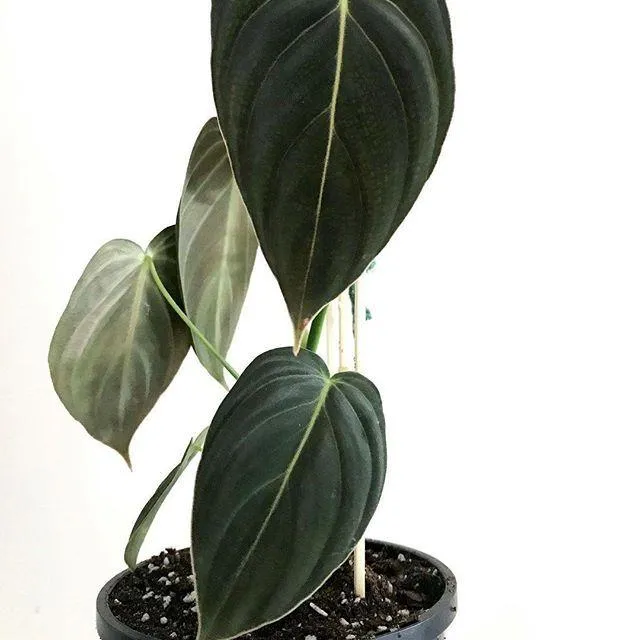Philodendron melanochrysum vs micans: Comparing the Black Cardinal and Micans Philodendrons
As an avid houseplant collector, I’m often asked about the differences between various philodendron varieties. Two that seem to generate a lot of questions are the black cardinal philodendron (Philodendron melanochrysum) and the micans philodendron (Philodendron hederaceum ‘Micans’). On the surface, they appear quite similar with their heart-shaped leaves and trailing vines. However, when you take a closer look there are some key distinguishing characteristics between these two beauties.
Appearance
At first glance, the leaves of the melanochrysum and micans look very similar in shape. Both produce dark green, glossy heart-shaped leaves. However, there are some differences in coloration. The melanochrysum, as its name suggests, has leaves with a beautiful blackish-purple hue on the undersides. This really makes the leaf color pop. The micans has a greenish-grey underside without the same intensity of dark coloring.
Another key visual difference is in the new leaf production. On the melanochrysum, new leaves emerge rolled up tightly like a scroll. As they unfurl, you can really see the dramatic blackish undersides. Micans leaves emerge flat rather than coiled. Over time, the colors on both can fade a bit if they don’t receive enough intense light.
Growth habit
In terms of growth pattern, the melanochrysum has a more compact, bushy habit compared to the vining micans. The melanochrysum sends out lateral shoots readily from the nodes to form a fuller plant. Micans has long, cascading vines that trail dramatically but doesn’t branch out as much. This makes melanochrysum better suited to more contained spaces while micans loves to spill over edges of hanging baskets and shelves.
Light and water preferences
When it comes to their care requirements, light is a key factor. Both need moderate to bright, indirect light to bring out their best coloration. However, in my experience the melanochrysum is a bit more finicky about light levels. It will struggle and lose its dark hues if light is too low. Micans is somewhat more forgiving and can tolerate low light better before fading.

As for water, I’ve found the micans to be slightly harder to overwater compared to the melochrysum. The melanochrysum prefers to dry out more between waterings while still getting sufficient moisture. Micans seems more tolerant of inconsistent watering without showing ill effects as quickly. Both prefer humid conditions like other philodendrons.
Growth rate
When assessing growth habit another factor is speed. In general, micans has a faster rate of growth, putting out new leaves more rapidly than the melanochrysum. This means micans vines will extend longer more quickly. However, the melanochrysum makes up for its slower pace by branching out bushier with time. So growth is steady with both, just expressed differently depending on the variety.
Price differences
Cost is another area where these philodendrons may vary. I’ve found established melanochrysum plants command a higher price tag compared to micans. This is likely due to its more compact form and dramatic darker leaves being more visually appealing. Finding well-established specimens of melanochrysum can also be more challenging. Young starter plants or cuttings of both species are available at a lower cost. Over time, care requirements even out the price differential as mature specimens of either variety become valuable.
Pest and disease resistance
When it comes to resilience, in my experience the micans seems to fare a bit better overall. It’s tough, hardy nature makes it less prone to pest or fungal issues. The melanochrysum can be more sensitive and susceptible to issues like spider mites if stressed. Both benefit from occasional insecticidal soap treatments as a preventative. Regular inspections help catch any potential problems early before they spread.
Personal plant profile
While I appreciate the unique qualities of both, if I had to pick a favorite it would be the melanochrysum. I’m drawn to its bolder coloration and more compact growth that allows it to shine in a contained space. Its curled new leaves never cease to delight me. I keep mine in a bright east-facing window where it thrives with high light levels. It’s been a very low maintenance addition to my collection for years now.

The trailing micans holds appeal too though. Its fast growth and tolerance of varied care make it great for spilling over shelves or hanging baskets. It reminds me of lush tropical foliage. A friend of mine keeps one trailing merrily in her kitchen that seems to grow forever! So both have their merits depending on individual tastes and growing conditions.
In summary…
To recap the key differences:
- Melanochrysum has purple-black leaf undersides, micans is green-grey
- Melanochrysum grows bushier, micans trails longer vines
- Melanochrysum needs brighter light, micans tolerates lower light
- Melanochrysum likes to dry slightly, micans stays moist
- Micans grows faster, melanochrysum spreads out bushier
- Mature melanochrysum plants cost more initially
- Micans is hardier with fewer pest/disease issues
In the end, both make gorgeous additions to any philodendron collection. I hope this breakdown of their characteristics helps you determine which variety may be the best fit depending on your tastes and growing conditions. Please let me know if you have any other questions!
Philodendron Melanochrysum vs Micans Comparison
| Characteristic | Melanochrysum | Micans |
|---|---|---|
| Leaf Color | Dark green with silver streaks | Light green |
| Leaf Shape | Heart-shaped | Oval |
| Leaf Texture | Soft, velvety | Smooth, thick |
| Growth Rate | Moderate | Fast |
| Care Level | Easy | Easy |
FAQ
-
What is the difference between a philodendron melanochrysum and a philodendron micans?
Basically, the philodendron melanochrysum and philodendron micans are similar species of flowering plants in the Araceae family. The main differences are in their leaf colors and patterns. The melanochrysum has leaves that are dark green on top with contrasting bright silver undersides, while the micans has leaves that are light green with dark spots or lines on both sides.
-
Do they have similar care requirements?
For the most part, the melanochrysum and micans have quite similar care needs. They both prefer bright, indirect light and humid conditions. You’ll want to water them when the top inch or two of soil is dry. They also like consistent temperatures around 70-80°F. Possibly the main difference is the melanochrysum may appreciate slightly higher humidity.

-
How fast do they grow?
From my experience, both of these philodendron types are modest but steady growers. You shouldn’t expect rapid growth, but given the right conditions, you’ll see new leaves unfurling every month or two. The melanochrysum may put on growth a little slower than the micans. It seems the micans pushes out leaves slightly quicker when Happy. Both can climb or trail nicely as they mature.
-
Which one would you recommend?
Hmm, that’s a tough decision! They’re both really lovely plants in my opinion. Maybe the melanochrysum has a slight edge because those silvery backs to the leaves look stunning. But the micans spots are also very handsome. Perhaps it comes down more to the available light in your home. If light is limited, the melanochrysum edges ahead since it tolerates lower light better. You really can’t go wrong with either though, in my view.
-
Do they need support to climb?
While the melanochrysum and micans can both climb or trail freely without support once established, giving them a moss pole or trellis to grow on does encourage more elongated growth. Over time, their aerial roots will anchor onto the pole helping them ascend upwards. So support is not completely necessary, but it does help maximize their climbing potential and showcase those beautiful patterns on their leaves.
-
How do you propagate them?
Propagating both the melanochrysum and micans is quite straightforward. You can take stem or node cuttings and place them in water or moist soil. Roots should develop within several weeks. Another neat method is to remove grown plants from their pots and tease them apart into smaller plants, then repot. Both of these methods have worked well for me in the past. Give the new plants the same humid, bright conditions as the parents.
So in summary, while both species have many similarities, the melanochrysum is perhaps a bit tougher with its silver leaf undersides. Still, the micans is hardly a slouch and both make great houseplants! Let me know if you need any other details on growing these awesome philodendrons.

